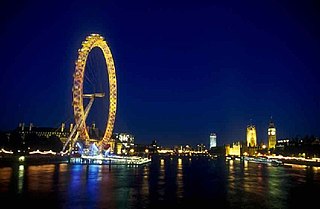See also
- Queen Elizabeth Bridge, Windsor, in Windsor, England
The Queen Elizabeth II Bridge is a bridge across the River Thames, England. Along with two tunnels, it forms part of the Dartford Crossing.
Queen Elizabeth II Bridge may also refer to:

The House of Windsor is a British royal house, and currently the reigning house of the United Kingdom and the other Commonwealth realms. Since it was founded in 1917, there have been five British monarchs of the House of Windsor: George V, Edward VIII, George VI, Elizabeth II, and Charles III. The children and male-line descendants of Queen Elizabeth II and Prince Philip also genealogically belong to the House of Oldenburg since Philip was by birth a member of the Glücksburg branch of that house.

The Gateshead Millennium Bridge is a pedestrian and cyclist tilt bridge spanning the River Tyne between Gateshead arts quarter on the south bank and Newcastle upon Tyne's Quayside area on the north bank. It was the first tilting bridge ever to be constructed. Opened for public use in 2001, the award-winning structure was conceived and designed by architectural practice WilkinsonEyre and structural engineering firm Gifford. The bridge is sometimes called the 'Blinking Eye Bridge' or the 'Winking Eye Bridge' due to its shape and its tilting method. The Millennium Bridge stands as the twentieth tallest structure in the city, and is shorter in stature than the neighbouring Tyne Bridge.
Victoria Bridge may be a reference to:

The Silver Jubilee of Elizabeth II marked the 25th anniversary of the accession of Queen Elizabeth II on 6 February 1952. It was celebrated with large-scale parties and parades throughout the United Kingdom and the Commonwealth throughout 1977, culminating in June with the official "Jubilee Days", held to coincide with the Queen's Official Birthday. The anniversary date itself was commemorated in church services across the land on 6 February 1977, and continued to be for the rest of that month. In March, preparations started for large parties in every major city of the United Kingdom, as well as for smaller ones for countless individual streets throughout the country.

The Golden Jubilee of Elizabeth II was the international celebration held in 2002 marking the 50th anniversary of the accession of Queen Elizabeth II on 6 February 1952. It was intended by the Queen to be both a commemoration of her 50 years as monarch and an opportunity for her to officially and personally thank her people for their loyalty.
Queen Elizabeth Hospital may refer to one of several institutions named after Queen Elizabeth I, Queen Elizabeth II or Queen Elizabeth the Queen Mother:

The Queen Elizabeth II Bridge carries the Tyne and Wear Metro between Newcastle upon Tyne and Gateshead over the River Tyne in North East England. The line is in tunnels on either side of the river and only emerges into open air to cross the bridge.

The Queen Elizabeth II Bridge, sometimes called the Beef Island Bridge, is a bridge, 70 meters (230 ft) long, that links Beef Island with Tortola in the British Virgin Islands. The original bridge was opened in 1966, and was replaced by a new bridge in 2003.
Chichester is a city in West Sussex, England.

Virginia Water Lake lies on the southern edge of Windsor Great Park, in the borough of Runnymede in Surrey and the civil parishes of Old Windsor and Sunningdale in Berkshire, in England. It is a man-made lake taking its name from a natural body of water of the same name. There is a village of Virginia Water which stretches out to the east of the lake. The grounds of the lake, nearby Fort Belvedere, and the Clockcase are all Grade I listed on the Register of Historic Parks and Gardens.

Romney Lock is a lock on the River Thames in England near Windsor and Eton, about half a mile downstream of Windsor Bridge. It is on the Windsor side of the river next to a boatyard and adjoins Romney Island, a long strip-shaped ait in the middle of the river. The first lock was built by the Thames Navigation Commission in 1798.

National Cycle Route 9 is a route of the National Cycle Network, running from Belfast to Dublin. It is the lowest-numbered route on the National Cycle Network outside of Great Britain.

The coronation of Elizabeth II as queen of the United Kingdom and the other Commonwealth realms took place on 2 June 1953 at Westminster Abbey in London. She acceded to the throne at the age of 25 upon the death of her father, George VI, on 6 February 1952, being proclaimed queen by her privy and executive councils shortly afterwards. The coronation was held more than one year later because of the tradition of allowing an appropriate length of time to pass after a monarch dies. It also gave the planning committees adequate time to make preparations for the ceremony. During the service, Elizabeth took an oath, was anointed with holy oil, was invested with robes and regalia, and was crowned Queen of the United Kingdom, Canada, Australia, New Zealand, South Africa, Pakistan, and Ceylon.

The Platinum Jubilee of Elizabeth II was the international celebration in 2022 marking the 70th anniversary of the accession of Queen Elizabeth II on 6 February 1952. It was the first time that any monarch in British history celebrated a platinum jubilee, as is the case in the histories of the other Commonwealth realms.

On 8 September 2022, at 15:10 BST, Elizabeth II, Queen of the United Kingdom, the other Commonwealth realms, and the longest-reigning British monarch, died at Balmoral Castle in Aberdeenshire, Scotland, at the age of 96. Her death was publicly announced at 18:30. She was succeeded by her eldest son, Charles III.